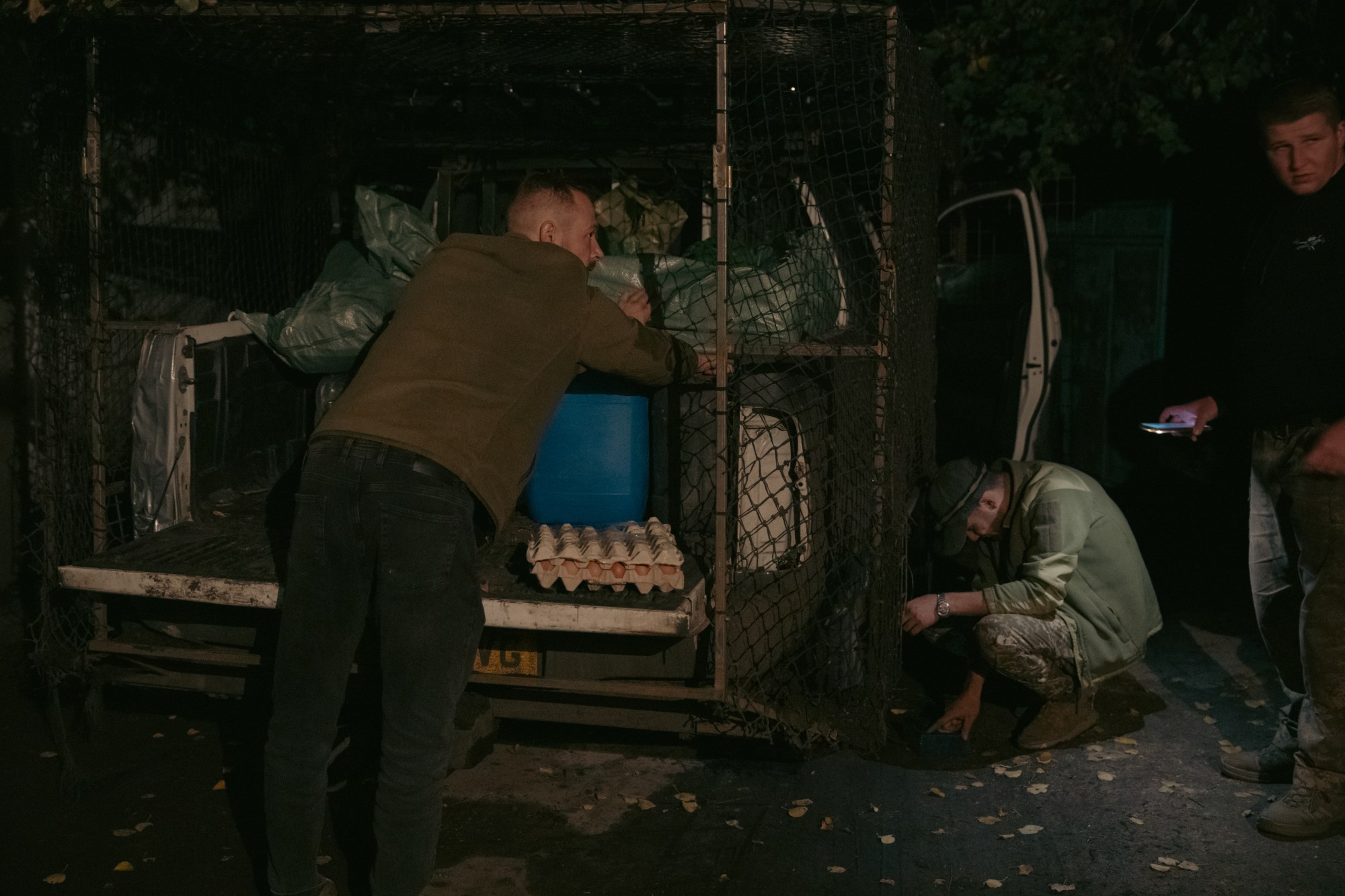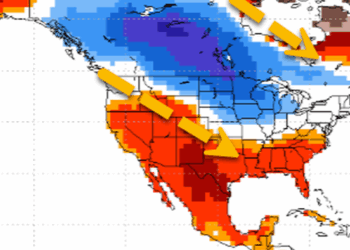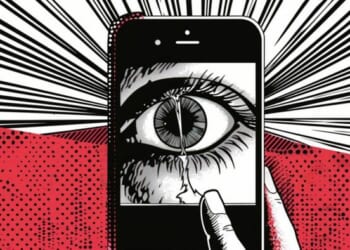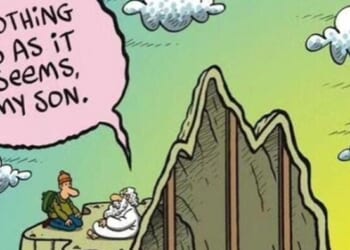NEAR POKROVSK, Ukraine—The soldiers of Ukraine’s 59th Brigade wait for nightfall. The earth exhales thin wisps of steam. Fall is nearly over, and the steppe is cooling.
Based near Mezhova—now largely destroyed and roughly 9 miles from the front line—the 59th Brigade has spent the past several months trying to contain the Russian push toward Pokrovsk. Once a city of about 60,000 people before the war, Pokrovsk is the last major stronghold in the southwestern sector of Donetsk oblast.
Long used as a key logistics hub for Ukraine’s defense of the Donbas, its fall would mark Russia’s most significant territorial gain since the capture of Bakhmut in May 2023. For Ukraine, it would be a setback with substantial political and military consequences, even if it is unlikely to fundamentally change the overall course of the war.
On November 19, 2025, U.S. President Donald Trump issued an ultimatum urging Ukraine to accept a 28-point peace plan reportedly co-drafted by U.S. special envoy Steve Witkoff and his Russian counterpart Kirill Dmitriev, a document that closely mirrored Kremlin demands. The plan, which included requiring Ukraine to surrender the Donetsk oblast, where Pokrovsk is located, was immediately rejected by Kyiv, European leaders, and several U.S. lawmakers. Their pushback led to a high-level U.S.-Ukraine meeting in Geneva, where Secretary of State Marco Rubio said the talks were “the best so far” and that both sides were reviewing the points. As of Tuesday, reports indicate that Ukrainian President Volodymyr Zelensky is willing to meet with Trump to discuss a revised plan.
The soldiers at the front have little time to consider any diplomatic efforts going on far away. After more than a year and a half of intense fighting, Russian forces, taking advantage of the pre-winter fog, have begun pouring into what remains of Pokrovsk and are reportedly already holding several neighborhoods. The soldiers of the 59th Brigade don’t even bother to hide it anymore: The city is about to fall. But that isn’t their concern.
“Since the drone war intensified, getting to a position has become more dangerous than staying in one. Russian drones now target Ukrainian logistics up to 12 miles behind the front. Getting within 2 miles of the contact line in a vehicle is close to suicide.”
They are already focused on what comes next if Pokrovsk falls, turning their attention to strengthening the defenses in the rear. While engineering teams have been hurrying for months to build shelters and trenches behind the city, the 59th Brigade is trying to slow the Russian advance.
Tonight’s mission falls to Aladdin, the unit’s driver, who is making another supply run toward the forward positions just 3.5 miles from the Russian lines. I’ll be joining him. His quartz-like eyes, sunk deep in their sockets, flicker between zeal and madness. He has the most dangerous job in the unit. He knows it. Everyone knows it. He laughs.
Tonight, he has to run a round trip to one of the unit’s drone positions—a small hideout manned by just two operators from the unit’s 10-man team. Working in near-total darkness, the pair spend their time assembling and preparing a heavy night-bomber drone known as the Vampire, a slow, hulking craft built to strike Russian positions after dusk.
Aladdin is waiting for two things before he can reach them: the cover of night and the battered vehicle he will drive down the shell-scarred road.
Since the drone war intensified, getting to a position has become more dangerous than staying in one. Russian drones now target Ukrainian logistics up to 12 miles behind the front. Getting within 2 miles of the contact line in a vehicle is close to suicide.
Only drone and artillery positions still get resupplied by car. For the rest, the soldiers on “line zero” walk in on foot, supplied by heavy cargo drones.
Aladdin is from Vinnytsia. His commander, Lev, 45, round-faced and quick to smile, claps him on the shoulder and turns to me, reassuringly. “He’s the best driver in the unit. With him, you feel like you’re flying on a magic carpet.”
Aladdin, in his early 20s, smiles. “Come on, he’s exaggerating.”
For now, he is still waiting for his vehicle. The Ukrainian army is short of everything—shells, jets, drones. Cars have become scarce, too, with life spans measured in months or even days. The few that survive are Mad Max machines, kept running by welding and prayer.
“We had five,” Lev says. He has just come back from medical leave. “Now we’re down to two.”
His right eardrum was blown out by the blast of a drone, and he still suffers from a concussion. Now he can only hear and communicate from his left side. He moves with the heavy, unsteady gait of a dazed bear.
Aladdin had bad news for him. “Our car took a drone hit.” The vehicle intended for the night’s mission had been hit just hours before.
“Any casualties?” Lev asks.
“No, they’re okay,” Aladdin reassures him. “But both the rear tires and the body need repairs.”
The departure.
After hours of waiting, the car finally shows up. It is 1 a.m. It’s wrapped in a metal cage meant to deflect drone strikes, and while the vehicle barely rolls on its axles, the cage did its job when the vehicle was struck hours before: The rear tires are shredded, and the airbags deployed.
Two wild-eyed men climb out and throw themselves into Lev’s arms.
The first, face soaked in sweat, holds a shotgun in one hand and a cigarette in the other. He bursts out laughing. The second, muttering curses without pause, walks around the car, inspecting the damage.

Aladdin rushes over. One soldier pulls out a long folding knife and slices away what is left of the airbags. Aladdin goes to fetch a jack and two new tires.
In a matter of minutes, the car is ready again. Other soldiers load the trunk with ammunition, water, and food. Aladdin and Sanik, who will ride with him, gear up.
Sanik, a young man with dark hair and thick eyebrows, had just woken from a nap and was about to join the trip in flip-flops and a hoodie when Lev shouted at him to put on a proper uniform. Still grumbling, he headed back to his room to change, slapping a magazine into his AK-47 as he walked.
“Our last line of defense against drones,” he jokes before pulling on a helmet fitted with night-vision goggles.
Aladdin checks the jammer mounted above the cab one last time. These improvised devices, often built from scavenged parts, tuned to only a few frequencies and powered by batteries that last only minutes, are designed to disrupt the guidance signals of incoming Russian drones. They stay off until he reaches the most dangerous stretch of road. Lev issues a final warning.
“Watch the road as much as the sky. There are more and more zhduny.” He’s talking about FPV drones, usually fiber-optic ones, placed directly on the road like mines, just waiting.
Aladdin nods and gives him a final slap on the back. Lev, almost paternal, checks our gear before we get into the car. A cigarette in his mouth, he makes sure my helmet is tight and that the tourniquet strapped to my bulletproof vest won’t fall off at the first bump.
Then he steps back, looks at us with a smile, and shakes our hands. “See you maybe tomorrow,” he says, and everyone starts to laugh.
‘They’re not shooting stars.’
Inside the cab is cramped, almost suffocating. Aladdin drives fast. On this first stretch, about 6 miles out and bringing us to roughly 3 miles from the contact line, he keeps the headlights on and mumbles along to a song crackling through the radio.
Now that we are in the car, all I can do is pray—but the adrenaline quickly takes over, and every passing second feels like a small victory. The night before this kind of reporting trip. I imagine the worst, and I review the maps, routes, and Telegram channels over and over. But the moment the car door closes, everything shifts. Fear loosens its grip. A soldier once told me, “In war, everything is fine … until it’s not.” The sentence sounds almost banal, but everyone here understands it.
After about 10 minutes, faces tighten. Aladdin kills the lights and covers the dashboard with a small tarp. Sanik crushes his cigarette and flicks it into the darkness, and the two men switch on their night-vision goggles at the same time.
Aladdin exhales and floors the accelerator. Sanik keeps his gaze fixed upward, scanning.
“If you see something move up there, they’re not shooting stars,” he warns as his last piece of advice.
The car slices through the steppe. At regular intervals explosions bloom on the horizon. We pass crumbling brick houses, abandoned train stations, and battered roads. Two explosions slam somewhere behind us.
“Normalno, normalno, it’s fine,” Aladdin says. Two drones have crashed. “They were tracking us. The jammer knocked them out.”
Another blast lights up a monument to the Great Patriotic War, as World War II is still known throughout the former Soviet Union.
“Welcome to Mezhova,” Sanik says, gripping his rifle, eyes locked on the ink-black sky.
“We are coming into the most dangerous part. Hold on,” Aladdin shouts.
He stomps the gas. The car bucks in the ruts. The metal cage rattles like loose chains on a ship.
Aladdin jerks the wheel. The tires screech. He dives onto a dirt track. More than once the car threatens to roll. He turns again, forcing the vehicle through, and finally plunges into a line of trees.
In the distance, a small red light sways. A young man with a drawn face walks toward them. Aladdin hits the brakes. The man with the headlamp pops the trunk, hauls out the crates in silence, then disappears into a hole camouflaged with branches.
Aladdin and Sanik grab rucksacks. Suddenly everything stops. The wind blends with a high-pitched whine. An FPV drone.
“One of ours?” Sanik asks.
“I don’t know,” Aladdin whispers.
The young man bursts back out of his burrow. “Move, move!” he yells.
Aladdin and Sanik do not hesitate. With packs on their backs, they dive in after him.
Somewhere in the distance the drone keeps circling. An explosion booms.
“Artillery, not a drone,” says the man with the lamp, catching his breath. His name is Serhii, but everyone calls him Raccoon. Headlamp still strapped to his forehead, he leads them deeper into the maze of trenches.
Trenches have evolved since the full-scale invasion began in 2022. Once muddy grooves in the earth, where soldiers carved small side burrows parallel to a narrow central path. trenches—known as blindage, “dugout” in Ukrainian—have become semi-permanent underground shelters. Central corridors are lined with small alcoves, individual sleeping rooms, makeshift toilets, and a compact command post.
The air is thick with the smells of freshly cut wood, cigarette smoke, and gasoline feeding a big generator that hums like some forest beast at the far end of the main corridor.
Racoon pushes deeper inside, then finally snaps his light off. He pulls aside a heavy camouflage curtain that serves as a door and reveals a command post packed with screens, drone joysticks, and gear. A man with a cigarette in his mouth answers a call over a walkie-talkie with a few flat words.
His name is Yurii. His call sign is “Oumni.” Eyes glued to a screen live-streaming the Pokrovsk front, he greets his comrade with the smallest nod.
A drone named ‘Vampire.’
Oumni, a 30-year-old engineer, is busy. He has found a Russian soldier hiding in the brush. On the screen, we see the man standing behind a line of birches, staring up at the sky. His movements are slow, numb. He drags a wounded leg. An observation drone buzzes overhead. Hopping on one foot, eyes still lifted toward the sky, he tries to reach another soldier a few meters away.
Oumni watches with his hands locked around the joystick. He makes a final adjustment. A flash. An explosion. The wounded soldier collapses and bursts into flames. His comrade barely has time to dive into a bush.
“Damn, we missed him. Send another drone, another one,” Oumni snaps.
Racoon darts back into the trench network. He grabs the explosive charges he will hang on the drone for its next mission, his headlamp beam slicing through the half-light, carving stark lines across his gaunt face.
At his screen, Oumni scans the treeline, bush by bush. “Where the hell did he go?”
A cat winds itself around his legs, but the 59th Brigade soldier does not look away from the feed.
“You see that fire on the screen?” he asks. “That is the Russian, burning. I think he is dead. But maybe not.” Oumni and Racoon barely react. On some nights, they can eliminate as many as 30 Russian soldiers. Oumni doesn’t dwell on his last target; without flinching, he’s already searching for the next one.

Then, beneath the constant rumble of artillery and the angry whine of FPV drones, another sound rolls in, deeper and almost deafening.
“Our baby is back,” Oumni says, smiling.
He means the Vampire, a heavy-lift drone. With about 40 minutes of flight time, it can carry up to 15 kilos of explosives, operate within a 6-mile radius and reach roughly 50 mph.
Ukrainian soldiers have told me that Russian soldiers call it Baba Yaga, after the mythical figure of Slavic folklore. In old stories she is a witch, an old woman, a hunter, sometimes a kind of minor goddess, feared for her power and unpredictability.
So at night, when they hear the low, harsh cry of a bomb-laden drone overhead, some think back to those childhood tales and the terror Baba Yaga inspired. A shape out of the dark, sometimes cruel, sometimes protective, but always inescapable, emerging from the shadows to test whoever crosses her path.
‘It’s almost like a video game.’
Racoon reappears, arms loaded with bombs. Calmly, he arms them. Then he slings on his body armor and helmet and crawls up the steps that lead out from the underground position.
The Vampire is hovering 30 feet or so away, level with their hideout, between the trees and a sunflower field. Racoon clips on the munitions, one by one.
Behind the hide, Oumni, a red-tinted lamp strapped to his helmet, checks that the antenna is still transmitting. Dawn sits over everything like a held breath. No birds. No falling leaves. Even the wind seems to have abandoned this cursed patch of earth.
Oumni listens. The sky is clear.
Back in the dugout, the two men crack open a can of Non Stop, an energy drink, and chain-smoke several cigarettes. Their faces are drawn.
It is barely 5 a.m. “The war mostly happens at night now,” Oumni says. “We have been working almost eight hours already, and we have killed more than 30 Russians. But it is not just strike missions. We also resupply the guys on line zero with water, food, and ammunition.”
“There he is, I see the bastard,” Racoon shouts, never taking his eyes off the live feed. “He is not moving, but his eyes are.”
On the screen, the face of a man who appears to be in his 30s comes into sharp focus. He has a trimmed beard, his helmet pulled low on his forehead. He is clutching his vest at the waist. He does not move. Only his eyes shift, tracking left and right inside his sockets.
“He’s scared,” Racoon says with a harsh little laugh. “He has a drone above him.”
Then the image blanks for a split second. A silent bloom of light.
“And bada-boom,” Racoon murmurs, setting down his controller and lighting another cigarette. “He’s dead.”
Raccoon is from the Kherson region. He is 29 and a career soldier. He has only been a drone operator for six months.
“I was in assault troops for almost three years. Then I got wounded, and they transferred me to this brigade,” he says.
He admits he is relieved. Drone operators have much better survival odds than infantry.
“When you are assaulting, you are in direct contact with the enemy. The hardest part is killing up close. Seeing a head explode, guts everywhere. … That messes with your head. I have killed more than 15 like that. After a while you cannot sleep and you see them in your nightmares. Here, behind a screen, it is like a video game. You do not really feel like you are killing someone.”
‘The days all blur together.’
Oumni, face pale, finally stands up. The night has been long. Buried in their trench, he says he no longer knows when it is day and when it is dark.
“You feel like you are in prison,” he says, smiling weakly. “Every day looks the same.”
Raccoon tries to unwind. Eyes sunk deep in the hollows of his shellshock, he plays a tank game on his phone. When you like your work, you keep at it.
“I like this one,” he says. “You can pick your tank, your ammo. This one is a World War II model.”
When he is not playing, he watches movies, cleans up the position, or does a bit of exercise. “My favorite movie as a kid was Superman. Now I watch everything, American films and Ukrainian ones.”
For them, morning is like evening. The mood is relaxed. Only the long sigh of glide bombs, shaking the shelter, cuts through. The sound of artillery or drones no longer fazes them.
Hunched over a small gas burner, Oumni cooks an omelette and chops in a couple of fresh tomatoes. He eats it greedily with a chunk of bread and a slice of bright pink sausage.
Earbuds in, he chats with his girlfriend, a woman from Vinnytsia he met just before he was mobilized. They trade stories from their day. He laughs.
“Her day is more interesting than mine. I feel like I am reliving the same thing every night.”
His face darkens. “I have only seen her twice this year,” he says. “War is not exactly the best way to build a solid relationship.”
“That is why I got divorced,” Raccoon cuts in. “I have a daughter and a son. They made me that drawing,” he says, pointing to a small paper angel with a heart in its hands taped above his bunk.
“For now, they are with their mother near Cherkasy.”
His expression clouds. He stands up slowly. “Maybe I should not say this, but morale has never been this low. We are losing this war. That is just a fact.”
Oumni tries to push back. “What does it mean to lose a war, Serhii? It could be worse.”
“Not losing means we stop retreating week after week,” Racoon snaps. He pauses, then continues in a tired voice. “You want to know why we fight? Because the choice is death or slavery.”
Eyes wild, voice calm, Serhii points a finger toward the invisible sky above them.
“I swear to God, if I get out of this alive, I will take a job that has nothing to do with war. I want to be a forest ranger, have a garden, take care of my plants. And I want to wear colorful clothes. Never this damn khaki uniform again.”
While he talks, Raccoon starts reassembling his AK-47. His face has gone hard. He looks like he is about to blow. With a sharp movement, he shoves open the door that leads back to daylight.
He climbs the steps one by one. Then, in a burst of powder smoke, shouts and gunfire, as if he could burn out what is eating him from the inside, he empties rounds into the empty landscape.
Raccoon comes back a few moments later. “Do not worry. Drones do not have ears.”

















